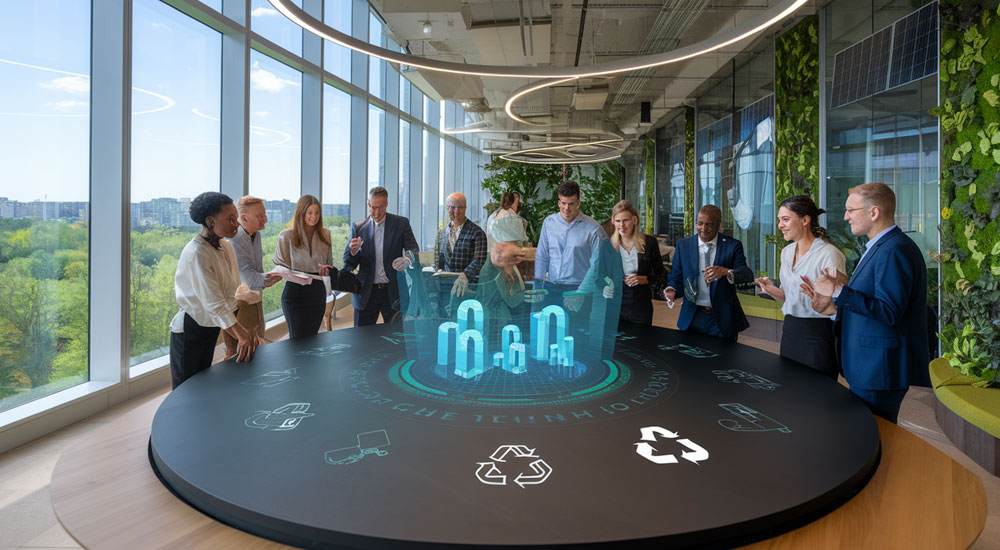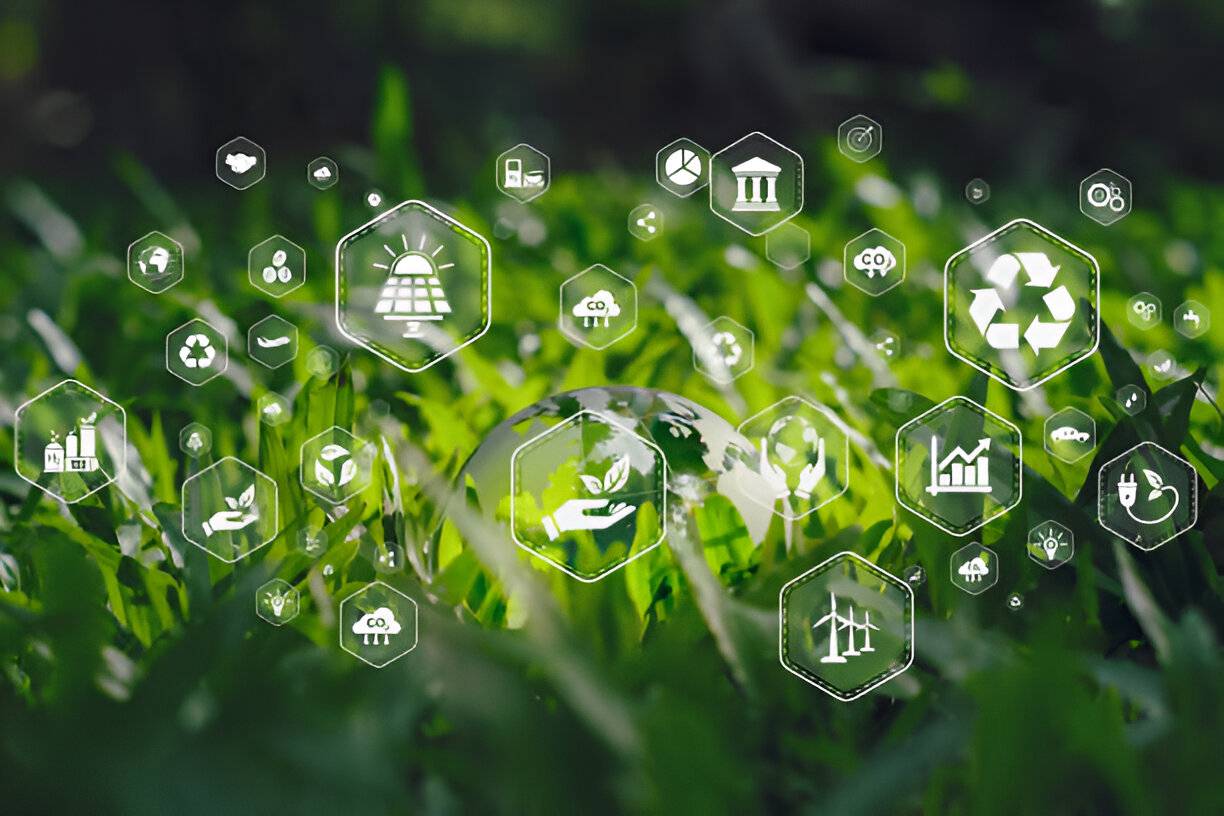Introduction
🌍 In a world grappling with climate change, resource depletion, and social inequality, businesses are facing a new imperative: sustainability. Gone are the days when profit was the sole measure of success. Today, companies must balance their financial goals with environmental stewardship and social responsibility. But why has sustainability become the new norm in the business world?
Imagine a future where your company thrives, not just financially, but as a force for positive change. A future where consumers flock to your products, investors clamor for your shares, and top talent competes to join your team. This isn’t a utopian dream—it’s the reality for businesses embracing sustainability. From Fortune 500 giants to nimble startups, companies are discovering that sustainable practices don’t just benefit the planet and society; they drive innovation, cut costs, and boost profits. 💡💰
In this blog post, we’ll uncover the transformative power of sustainable business practices. We’ll explore why 90% of executives acknowledge sustainability’s importance, yet only 60% have implemented strategies. From defining what sustainable business really means to examining successful models and future trends, we’ll equip you with the knowledge to navigate this new business landscape. Are you ready to discover how your business can thrive while making a positive impact on the world? Let’s dive in! 🏊♂️
Defining Sustainable Business
A. Environmental responsibility
Sustainable businesses prioritize environmental responsibility as a core principle. This involves adopting practices that minimize negative impacts on the environment and actively promote ecological well-being. Key aspects include:
- Implementing a precautionary approach to environmental challenges
- Encouraging initiatives that foster greater environmental responsibility
- Promoting the development and diffusion of environmentally friendly technologies
Companies can demonstrate environmental responsibility by:
- Optimizing supply chains to reduce carbon footprints
- Utilizing renewable energy sources
- Employing eco-friendly materials in production processes
B. Social impact
A sustainable business model also emphasizes positive social impact. This encompasses:
- Supporting and respecting internationally recognized human rights
- Upholding labor rights, including freedom of association and collective bargaining
- Eliminating forced labor, child labor, and employment discrimination
Businesses can enhance their social impact through:
| Strategy | Example |
|---|---|
| Community engagement | Supporting local education initiatives |
| Ethical labor practices | Ensuring fair wages and safe working conditions |
| Diversity and inclusion | Promoting equal opportunities in the workplace |
C. Economic viability
While focusing on environmental and social responsibilities, sustainable businesses must maintain economic viability. This involves:
- Aligning sustainability initiatives with corporate goals
- Enhancing financial performance through improved ESG (Environmental, Social, and Governance) metrics
- Creating shared value that benefits both the company and society
D. Long-term value creation
Sustainable businesses prioritize long-term value creation over short-term profits. This approach involves:
- Considering the lasting impacts of decisions on financial performance, environmental health, and social equity
- Regularly updating business models to align with sustainability goals
- Setting measurable transformation objectives
To achieve long-term value creation, businesses should:
- Conduct regular assessments of stakeholder needs
- Integrate stakeholder feedback into decision-making processes
- Establish science-based targets for reducing greenhouse gas emissions
- Prioritize long-term resilience in strategic decisions
By embracing these four key elements of sustainable business, companies can create a meaningful impact over time while ensuring their own longevity and success.
With this comprehensive understanding of sustainable business, we can now explore “The Rise of Sustainability in Business” to understand how these principles have gained prominence in the corporate world.
The Rise of Sustainability in Business
Now that we have defined sustainable business, let’s explore the rising importance of sustainability in the corporate world.
A. The Importance of Sustainability in Business
Sustainability has become a critical commercial driver for businesses worldwide. Despite complex challenges such as geopolitical disruptions, volatile policies, and climate change impacts, companies and investors remain committed to sustainable practices. This commitment stems from several key factors:
B. Changing Consumer Preferences
Consumers are increasingly aware of environmental issues, leading to a shift in preferences towards eco-friendly products and services. This change in consumer behavior has prompted businesses to adapt their strategies to meet these evolving demands.
C. Regulatory Pressures
The regulatory landscape for sustainability is rapidly evolving:
- Implementation of the EU Corporate Sustainability Reporting Directive (CSRD)
- Anticipated new disclosure standards for physical climate risks
- Potential global treaty to tackle plastic pollution
These regulations are challenging companies to measure and report on their value chain sustainability impacts, often requiring new capabilities and strategies.
D. Investor Demands
Investors are recognizing the importance of sustainability in long-term business success. This is evident in the growing market for green, social, sustainability, and sustainability-linked bonds (GSSSB), despite tough borrowing conditions.
| Type of Bond | Focus Area |
|---|---|
| Green | Environmental projects |
| Social | Social impact initiatives |
| Sustainability | Combined environmental and social objectives |
| Sustainability-linked | Tied to specific sustainability performance targets |
E. Competitive Advantage
Embracing sustainability can provide businesses with a significant competitive edge:
- Enhanced resilience against climate-related risks
- Improved operational efficiency through resource optimization
- Attraction and retention of environmentally conscious consumers
- Potential for innovation in green technologies and circular economy solutions
As we move forward, it’s clear that sustainability is not just a trend but a fundamental aspect of modern business strategy. With this in mind, next, we’ll explore the key areas of sustainable business practices that companies are implementing to address these evolving demands and challenges.
Key Areas of Sustainable Business Practices
Now that we have explored the rise of sustainability in business, let’s delve into the key areas where sustainable practices are being implemented. These areas form the foundation of a comprehensive approach to corporate sustainability.
Green Supply Chain Management
Green supply chain management focuses on minimizing environmental impact throughout the entire supply chain. Companies like Unilever have demonstrated the power of collaborative efforts in sustainable sourcing. By partnering with stakeholders to source sustainable palm oil, Unilever has shown how businesses can benefit both the environment and their bottom line.
Circular Economy Initiatives
Circular economy initiatives aim to reduce waste and maximize resource efficiency. This approach aligns with the concept of the triple bottom line—people, planet, and profit—advocated by Professor Rebecca Henderson. By implementing circular economy practices, businesses can:
- Minimize waste
- Reduce resource consumption
- Create new revenue streams
- Enhance brand reputation
Renewable Energy Adoption
The transition to renewable energy sources is a critical component of sustainable business practices. Many large corporations have set carbon neutrality goals, recognizing the importance of addressing climate change. This shift not only reduces environmental impact but also:
| Benefits of Renewable Energy Adoption |
|---|
| Lower long-term energy costs |
| Improved energy security |
| Enhanced brand image |
| Compliance with regulations |
Waste Reduction Strategies
Effective waste reduction strategies are essential for sustainable business operations. Richard Wilner’s framework of overlapping timelines provides a practical approach to addressing waste issues:
- Immediate goals: Quick wins and easy implementations
- Medium-term goals: Process improvements and technology adoption
- Long-term goals: Fundamental changes in product design and materials
Ethical Labor Practices
Ethical labor practices are increasingly recognized as a crucial aspect of sustainable business. This area intersects with the growing emphasis on diversity, equity, inclusion, and justice (DEIJ) in corporate sustainability efforts. By integrating DEIJ with sustainability initiatives, companies can:
- Support healthier communities
- Promote equitable economic transitions
- Address the disproportionate effects of climate change on marginalized communities
As we move forward to explore the benefits of embracing sustainability, it’s clear that these key areas of sustainable business practices form a interconnected framework for creating long-term value for organizations, stakeholders, and society as a whole.
Benefits of Embracing Sustainability
Now that we have explored the key areas of sustainable business practices, let’s delve into the numerous benefits that companies can reap by embracing sustainability. These advantages not only contribute to a company’s bottom line but also positively impact society and the environment.
A. Cost savings and efficiency
Implementing sustainable practices often leads to significant cost reductions and improved operational efficiency. According to McKinsey research, resource efficiency policies can boost operating profits by up to 60%. For instance:
- Unilever has saved approximately €1.5 billion since 2008 through energy and water efficiency measures.
- Companies that prioritize sustainability can better navigate potential carbon taxes, positioning themselves as industry leaders in combating climate change.
B. Enhanced brand reputation
Sustainability efforts can significantly improve a company’s brand image and reputation:
- 84% of business leaders believe economic growth can coexist with climate goals.
- 75% of companies are increasing their sustainability investments, signaling a growing industry trend.
- Purpose-driven businesses demonstrated a remarkable 175% growth rate between 2008 and 2020, compared to 70% for those lacking a defined purpose.
C. Increased customer loyalty
Modern consumers are increasingly demanding transparency and accountability from businesses:
| Consumer Behavior | Market Opportunity |
|---|---|
| 22% making more sustainable purchasing decisions | $456 billion in the fast-moving consumer goods sector |
By aligning products with clear environmental and social benefits, companies like Unilever are fostering sustainable living and attracting loyal customers.
D. Improved employee satisfaction and retention
Sustainability initiatives can have a positive impact on employee engagement and retention:
- Companies prioritizing environmental, social, and governance (ESG) metrics tend to outperform their peers in profitability.
- Sustainable practices serve as a competitive advantage in attracting and retaining top talent.
- Employees are more likely to feel satisfied working for companies that demonstrate a commitment to social responsibility and environmental stewardship.
By embracing sustainability, businesses can create a positive work environment that aligns with employees’ values, leading to increased job satisfaction and reduced turnover rates.
With these benefits in mind, next, we’ll explore the challenges that companies may face when implementing sustainable practices. While the advantages are clear, it’s important to understand the potential obstacles to overcome for successful integration of sustainability into business operations.
Challenges in Implementing Sustainable Practices
Now that we have explored the benefits of embracing sustainability, it’s crucial to understand the challenges businesses face when implementing sustainable practices. While the advantages are clear, companies often encounter several obstacles on their journey towards sustainability.
A. Initial investment costs
One of the primary challenges in implementing sustainable practices is the upfront costs involved. Similar to installing solar panels, many sustainable initiatives require significant initial investments. For example:
- Upgrading to energy-efficient equipment
- Implementing fair labor practices
- Adopting green technologies
While these investments often lead to long-term benefits such as energy efficiency and reduced employee turnover, the initial financial burden can be substantial, especially for small and medium enterprises (SMEs).
B. Resistance to change
Implementing sustainable practices often requires a shift in organizational culture and operations. This can lead to resistance from various stakeholders:
- Employees may be hesitant to adopt new processes
- Management might prioritize short-term goals over long-term sustainability
- Suppliers may struggle to meet new sustainability standards
To overcome this challenge, companies need to focus on creating a culture of sustainability by integrating ESG metrics into performance evaluations and ensuring transparent communication throughout the organization.
C. Measuring and reporting impact
Accurately measuring and reporting sustainability efforts poses significant challenges:
- Navigating complex government regulations
- Providing transparency to stakeholders
- Lack of standardized metrics for sustainability performance
| Challenge | Impact |
|---|---|
| Data security concerns | Hinders effective reporting |
| Insufficient support from top management | Impedes implementation of measurement systems |
| Workforce skill deficits | Affects accuracy of sustainability metrics |
Companies must invest in data-centered solutions and sensor-aided cyber-physical systems to overcome these obstacles and provide meaningful sustainability reports.
D. Balancing short-term and long-term goals
One of the most significant challenges is striking a balance between immediate business priorities and long-term sustainability objectives:
- Short-term financial targets may conflict with sustainability investments
- Pressure to maintain competitive pricing while adopting sustainable practices
- Limited resources, especially for SMEs, to pursue both short-term and long-term goals simultaneously
To address this challenge, businesses need to adopt a holistic approach that integrates sustainability into their core strategy, considering broader societal impacts such as community welfare and employee diversity.
As we move forward to explore successful sustainable business models, it’s important to keep these challenges in mind. By understanding and addressing these obstacles, companies can develop more effective strategies for implementing sustainable practices and reaping their long-term benefits.
Successful Sustainable Business Models
Now that we’ve explored the challenges in implementing sustainable practices, let’s examine some successful sustainable business models that have overcome these hurdles and are leading the way in corporate sustainability.
B Corporations
B Corporations, or B Corps, are certified companies that meet high standards of social and environmental performance, transparency, and accountability. These businesses prioritize people, planet, and profit, embodying the triple bottom line framework. Examples include:
- Patagonia: Known for its long-standing commitment to environmental stewardship and transparency
- Seventh Generation: Recognized for eco-friendly products and sustainable packaging
Social Enterprises
Social enterprises are businesses that aim to address social or environmental issues while generating profit. These organizations often reinvest their profits into their mission. Key characteristics include:
- Focus on fair trade practices
- Support for local communities
- Emphasis on ethical working conditions
| Company | Social Impact |
|---|---|
| Dr. Bronner's | Fair trade and organic products |
| tentree | Plants ten trees for every product sold |
Green Tech Innovators
Green technology companies are at the forefront of sustainable innovation, developing solutions to reduce environmental impact. Microsoft exemplifies this category by:
- Utilizing renewable energy
- Fostering mindfulness and community collaboration
- Enhancing access to green spaces for employees
Circular Economy Pioneers
Circular economy businesses focus on minimizing waste and maximizing resource efficiency. These companies design products and processes with reuse and recycling in mind. Notable examples include:
- New Belgium Brewing: Pioneer in zero waste practices
- Pela: Produces compostable phone cases
- Unilever: Initiatives to eliminate plastic waste and combat food waste in production processes
These sustainable business models demonstrate that prioritizing environmental and social responsibility can lead to meaningful change and business success. As we look towards the future trends in sustainable business, these pioneers are setting the stage for wider adoption of eco-friendly practices and innovative solutions to global challenges.
Future Trends in Sustainable Business
Now that we’ve explored successful sustainable business models, let’s look ahead to the future trends shaping sustainable business practices.
AI and sustainability
Artificial Intelligence (AI) is poised to play a crucial role in advancing sustainability efforts. Companies are leveraging AI to optimize resource use and enhance efficiency. For instance, precision agriculture utilizes AI-driven technologies like GPS and drones to minimize land and water consumption. This approach not only reduces environmental impact but also improves crop yields, demonstrating how AI can contribute to both sustainability and profitability.
Blockchain for transparency
Blockchain technology is emerging as a powerful tool for promoting supply chain transparency and ensuring ethical standards. By providing an immutable record of transactions and product journeys, blockchain enables:
- Verification of sustainable sourcing
- Tracking of carbon footprints
- Enhanced consumer trust
| Blockchain Benefits | Impact on Sustainability |
|---|---|
| Traceability | Ensures ethical sourcing |
| Immutability | Prevents greenwashing |
| Transparency | Builds consumer trust |
Looking to Simplify Financial Planning and Analysis?
Discover tailored FP&A solutions designed to help startups and SMBs streamline budgeting, forecasting, and decision-making for sustainable growth.
Regenerative business practices
The concept of regenerative business is gaining traction, moving beyond sustainability to actively restore and improve the environment. Key areas include:- Circular economy models: Companies like Interface Inc. and Mud Jeans are pioneering closed-loop recycling and leasing systems to minimize waste.
- Biodegradable materials: Innovations in packaging, such as Ecovative Design’s mycelium-based solutions, are reducing reliance on traditional plastics.
- Carbon capture and utilization (CCU): Technologies are being developed to capture CO2 emissions and repurpose them, contributing to a circular carbon economy.
Collaborative ecosystems
The future of sustainable business lies in collaborative ecosystems where companies, startups, and institutions work together to drive innovation. This trend is exemplified by:- Green building initiatives: Partnerships to develop and implement sustainable construction materials and practices.
- Renewable energy collaborations: Joint efforts to accelerate the adoption of clean energy technologies.
- Cross-industry sustainability alliances: Shared commitments to reducing environmental impact, such as Google’s pledge to operate on carbon-free energy by 2030.
Conclusion
Sustainability has become the new norm in today’s business world, and for good reason. As we’ve explored, embracing sustainable practices offers numerous benefits, from improved brand reputation and talent attraction to cost savings and access to new markets. Companies that prioritize the triple bottom line approach—people, planet, and profit—are not only contributing to global environmental and social challenges but are also positioning themselves for long-term success and competitiveness.
The journey towards sustainability is not without its challenges, but the rewards far outweigh the obstacles. By integrating sustainable practices across all business operations, collaborating with stakeholders, and transparently reporting progress, companies can drive positive change while ensuring their own viability. As we look to the future, it’s clear that sustainability will continue to shape the business landscape. Those who embrace this shift now will be better equipped to thrive in an evolving market, meet growing consumer demands, and contribute to a more sustainable world for generations to come.









